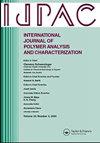Development of poly(lactic acid) nanocomposite films with kaolin/bentonite blended clay for packaging applications
IF 1.7
4区 工程技术
Q4 POLYMER SCIENCE
International Journal of Polymer Analysis and Characterization
Pub Date : 2025-04-03
DOI:10.1080/1023666X.2024.2438724
引用次数: 0
Abstract
In this study, Kaolinite clay from the North-East Region (NER) of India was blended with bentonite clay and incorporated into poly(lactic acid) (PLA) at different concentrations of: 1%, 3%, 5%, and 7 weight% (wt%) through the solvent casting method. The resulting films were characterized by using the Fourier transform infrared (FTIR) spectroscopy to investigate the interactions among the various functional groups. The X-ray diffraction (XRD) analysis was performed to determine the composites’ structure and crystallinity, while the thermogravimetric analysis (TGA) was employed to assess the thermal stability of the films. Furthermore, mechanical properties, such as the tensile strength, Young’s modulus, and elongation-at-break (%) were evaluated. The maximum tensile strength of 36.9 MPa was attained for the PLA film blended with 7 wt% of clay. However, the elongation-at-break (%) for this specimen was lower when compared to the neat PLA film. Field emission scanning electron microscopy (FE-SEM) analysis provided insights into the morphology of the poly(lactic acid)–NER kaolinite/bentonite blend clay nanocomposite films, thereby revealing significant aggregation and agglomeration within the specimen containing the 5 wt% of filler. Moreover, the packaging application of the films developed was evaluated to enhance the shelf life of fresh black grapes. The results revealed that the unpackaged grapes experienced spoilage, while those wrapped in the films (PLA-7%) developed and showed no signs of deterioration after the 14 days of storage at room temperature. These findings suggest that the newly developed nanocomposite films could serve as an effective option for fruits packaging applications.
包装用高岭土/膨润土混合粘土聚乳酸纳米复合膜的研制
在这项研究中,来自印度东北地区(NER)的高岭土粘土与膨润土粘土混合,并通过溶剂铸造法将不同浓度的聚乳酸(PLA)掺入:1%,3%,5%和7重量% (wt%)。利用傅里叶变换红外光谱(FTIR)对所得薄膜进行了表征,研究了各种官能团之间的相互作用。采用x射线衍射(XRD)分析复合材料的结构和结晶度,热重分析(TGA)评价复合材料的热稳定性。此外,力学性能,如抗拉强度,杨氏模量和断裂伸长率(%)进行了评估。当粘土掺量为7%时,PLA薄膜的最大拉伸强度为36.9 MPa。然而,与纯PLA薄膜相比,该试样的断裂伸长率(%)较低。场发射扫描电镜(FE-SEM)分析揭示了聚乳酸-NER高岭石/膨润土混合粘土纳米复合膜的形貌,从而揭示了含有5 wt%填料的样品内显着的聚集和团聚。并对所研制薄膜在提高新鲜黑葡萄保质期方面的包装应用进行了评价。结果表明,未包装的葡萄出现了变质现象,而包裹在薄膜(PLA-7%)中的葡萄在室温下储存14天后没有出现变质迹象。这些发现表明,新开发的纳米复合薄膜可以作为水果包装应用的有效选择。
本文章由计算机程序翻译,如有差异,请以英文原文为准。
求助全文
约1分钟内获得全文
求助全文
来源期刊
CiteScore
3.50
自引率
5.30%
发文量
37
审稿时长
1.6 months
期刊介绍:
The scope of the journal is to publish original contributions and reviews on studies, methodologies, instrumentation, and applications involving the analysis and characterization of polymers and polymeric-based materials, including synthetic polymers, blends, composites, fibers, coatings, supramolecular structures, polysaccharides, and biopolymers. The Journal will accept papers and review articles on the following topics and research areas involving fundamental and applied studies of polymer analysis and characterization:
Characterization and analysis of new and existing polymers and polymeric-based materials.
Design and evaluation of analytical instrumentation and physical testing equipment.
Determination of molecular weight, size, conformation, branching, cross-linking, chemical structure, and sequence distribution.
Using separation, spectroscopic, and scattering techniques.
Surface characterization of polymeric materials.
Measurement of solution and bulk properties and behavior of polymers.
Studies involving structure-property-processing relationships, and polymer aging.
Analysis of oligomeric materials.
Analysis of polymer additives and decomposition products.

 求助内容:
求助内容: 应助结果提醒方式:
应助结果提醒方式:


